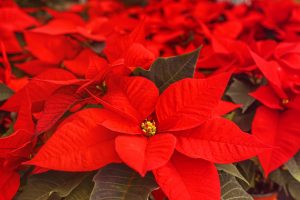
‘Tis the season to see poinsettias in supermarkets, department stores, churches, and maybe even in your own home. This was not always the case in the United States. After finding this plant growing along the side of the road in Taxco, Mexico, Dr. Joel Poinsett, amateur botanist, physician and the first U.S. ambassador to Mexico, sent cuttings back to his home in South Carolina in 1828. While most botanists of the time considered it a weed, Dr. Poinsett continued to study and breed the plant in his greenhouse and share his plants with his horticulturist friends. In the United States, poinsettias are named in honor of him. Since the mid-1800s, the United States has observed December 12th, the anniversary of Dr. Poinsett’s death, as National Poinsettia Day.
In Mexico and Guatemala, this plant is known as Flor de la Nochebuena, or Flower of the Holy Night. The Holy Night being Christmas Eve. The colorful leaves of this plant are thought to resemble the Star of Bethlehem. Besides being used as decoration at Christmastime, poinsettias are used as decoration to celebrate the feast of Our Lady of Guadalupe in Mexico on December 12, a national holiday commemorating the belief that Jesus’ mother Mary, who is Mexico’s patron saint, appeared to a man in Mexico City on December 9 and 12 in 1531.
In temperate climates, the plants are perennial shrubs that can grow as high as 10-12 feet tall. In the early 1900s, Paul Ecke, Sr. developed the first poinsettia that could be grown indoors as a potted plant. He grew them in open fields along Sunset Boulevard and sold them at roadside stands in Hollywood. However, his son, Paul Ecke, Jr. is credited with being the father of the poinsettia industry. In 1965, under his supervision, hybridizers at Ecke Ranch in California created a plant whose blooms lasted more than a week and whose leaves stayed on the plant for more than a few days. He also developed a growing technique that caused the seedlings to branch, creating a fuller and more aesthetically pleasing plant. Paul Ecke, Jr. contributed to the current popularity of poinsettias by donating them to leading women’s magazines for their holiday layouts1 and to popular TV shows such as The Tonight Show, the Dinah Shore Show and the Bob Hope Christmas Specials in order to stimulate demand among consumers. By 1986, the poinsettia was the top-selling potted plant in the United States. When Ecke Ranch was sold to the Dutch company Agribio Group in 2012, it commanded more than 70% of the market in the United States and 50% of the worldwide market.
In terms of dollar value, Christmas/Hanukkah is the top floral buying holiday. Thirty percent of consumers purchase flowers or plants as gifts during this time of year. Of those, 53% purchase poinsettias. There are currently more than 100 varieties. The most popular color by far is red (74%), followed by white (8%), pink (6%) and mixed (3%).
Today’s market size shows the value of wholesale sales of potted poinsettias in 2015 and 2018 in the United States.2 In 2018, nearly 34.2 million potted poinsettias were sold at wholesale, up from 31.97 million in 2015. In the United States, 96% of poinsettias produced are sold at wholesale. In both 2015 and 2018, the top two states in terms of both dollar sales and units sold were California and North Carolina. In 2018, more than 7 million potted poinsettias were sold at wholesale in California valued at $29.4 million, up from nearly 5.8 million sold in 2015 with a value of $29.3 million. In North Carolina, 3.8 million potted poinsettias were sold at wholesale in 2018, down from 4.3 million in 2015. The value of the plants sold also dropped from $16.4 million in 2015 to $14.1 million in 2018. In 2015, Florida rounded out the top 3 with 3.1 million plants sold valued at $12.3 million. However, in 2018, New York was third in dollar sales ($12.4 million) and Michigan was third in units sold (nearly 2.8 million). In 2015, there were 578 producers; in 2018, 581.
1 Because magazines created their Christmas layouts in July and August, Ecke, Jr. needed to bloom plants out of season.2 Businesses with $100,000 or more in sales.
Geographic reference: United States
Year: 2015 and 2018
Market size: $139.7 million and $148.8 million, respectively
Sources: Floriculture Crops 2018 Summary, United States Department of Agriculture, National Agricultural Statistical Service, May 2019 available online here; Dr. Leonard Perry, “Fun Facts About Poinsettias,” University of Vermont Extension, Department of Plant and Soil Science available online here; Susan La Fountaine, “Master Gardener: Here’s How Plants Became Part of the Christmas Story,” Fremont News Messenger, November 19, 2019 available online here; Erica D. Seltzer and MaryAnne Spinner, “Poinsettia Facts,” University of Illinois Extension available online here; “Christmas/Hanukkah Floral Statistics,” About Flowers, Society of American Florists, 2018 available online here; Elaine Woo, “Paul Ecke Jr., 76; Made Poinsettia U.S.’ Top-Selling Potted Plant,” Los Angeles Times, May 16, 2002 available online here; Matt Krantz, “Paul Ecke Sr.: ‘Poinsettia King’ Cultivated A Holiday Tradition,” Investor’s Business Daily, November 21, 2018 available online here; “Feast of Our Lady of Guadalupe in the United States,” timeanddate.com available online here.
Image source: Susanne Jutzeler, suju-foto, “poinsettia-adventsstern-4636921,” Pixabay, November 22, 2019 available online here.
